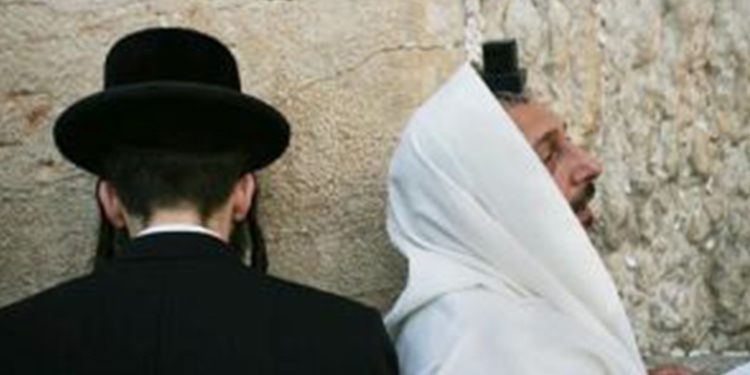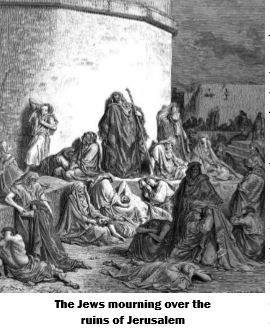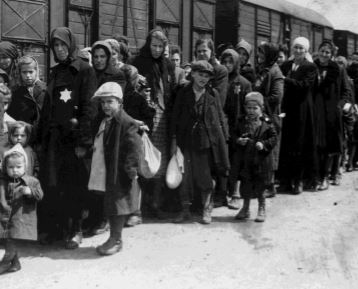What is Tisha B’Av? – Overview

Tisha B’Av (the Fast of the Ninth of Av) is a day of mourning to commemorate the many tragedies that have befallen the Jewish people, many of which have occurred on the ninth day of the Jewish month of Av. In particular, Tisha B’Av commemorates the destruction of the two Jerusalem Temples—the first in 586 BCE (Before the Common Era) and the second in 70 CE (Common Era).
Tisha B’Av, one of two “full-day” fasts in the Jewish year (the other occurs at Yom Kippur), is the culmination of a three-week period of mourning called “The Three Weeks” in English or Bein HaMitzarim (literally, “between narrow straits”) in Hebrew. This name comes from a verse in the Book of Lamentations, which is traditionally read on Tisha B’Av:

Judah has gone into captivity,
Under affliction and hard servitude;
She dwells among the nations,
She finds no rest;
All her persecutors overtake her in dire straits. (Lamentations 1:3, NKJV)
The three weeks of mourning begins with the fast of Shivah Asar B’Tammuz (meaning the 17th day of the Hebrew month, Tammuz), which was instituted to mark the breach of the Jerusalem walls during the Babylonian siege in 586 BCE. According to tradition, it also marks a number of other tragedies that befell the Jewish people after that day, including the halting of daily temple sacrifices and the burning of the Torah after the Babylonian invasion, and the erection of idols in the Temple during the Roman occupation. It is also considered the day on which Moses broke the first set of tablets containing the Ten Commandments after coming down Mt. Sinai to discover the people worshiping the golden calf. (See Exodus 32.)

The three weeks leading up to Tisha B’Av are viewed as a time of quasi-mourning, a time devoted to solemnity and reflection. During this time, the Jewish people refrain from personal indulgence and joyous activities. Weddings, parties, and other festive events are not permitted. In the last nine days of this period, leading up to the ninth of Av, the intensity of mourning increases—people refrain from eating meat or drinking wine; bathing, beyond what is absolutely necessary, is prohibited, as is doing laundry, and buying or wearing new clothes.
This period of mourning concludes in the Fast of Tisha B’Av, a day that is spent entirely in mourning—fasting, praying, sitting on stools instead of chairs, and reading the Book of Lamentations, a poem recounting the prophet Jeremiah’s grief for the fallen city of Jerusalem. Fellowship Founder Rabbi Yechiel Eckstein wrote in his book, How Firm a Foundation, “[Tisha B’Av] is the blackest, most sorrowful day in the Jewish year. . . . Unlike the fast of Yom Kippur, which is one of repentance, that of Tisha B’Av is one of mourning and sadness” (p. 129).
Not only does the date mark the destruction of the two Jerusalem Temples at different times in Jewish history, but it also marks the date of other tragedies that have befallen the Jews: God’s decision to not allow the generation of the Exodus to enter the Promised Land; the suppression of Bar Kochba’s revolt, thus ending Jewish resistance to the Romans (135 CE); the expulsion of the Jews from Spain and the onset of the Spanish Inquisition (1492); and the deportation of Jews from the Warsaw ghetto to the Treblinka concentration camps (1942).
“We are to vicariously feel the depth of grief and sadness that has marked this date throughout history,” Rabbi Eckstein wrote. “For we, too, are mourners on Tisha B’Av; we too, ‘let [our] tears flow like a river day and night” over the fall of Jerusalem” (Lamentations 2:18).

Yet, even this saddest of days for the Jewish people, is not without hope. In the afternoon of Tisha B’Av, the people rise from their mourning stools and recall the tradition that says in messianic times, this time of mourning will turn into a time of great joy and celebration. On the Sabbath following Tisha B’Av, and on the next seven Sabbaths leading up to Rosh Hashanah (the Jewish New Year), prophetic selections of consolation are read, known as The Comfortings. As Rabbi Eckstein wrote, this is a “reminder that despite the adversities and affliction marking Jewish history, God’s covenant with His people, Israel, remains in effect; His promise of redemption yet fulfilled, ‘The LORD your God will restore your fortunes and have compassion on you, and he will gather you again from all the nations where he has scattered you’” (Deuteronomy 30:3).
While some may think it strange to dwell and focus on such suffering and horrendous events, it is, in fact, biblical for Jews to not forget. The psalmist wrote in Psalm 137:5-6: “If I forget you, Jerusalem, may my right hand forget its skill. May my tongue cling to the roof of my mouth if I do not remember you, if I do not consider Jerusalem my highest joy.”
And so, as Rabbi Eckstein wrote, “We continue to commemorate past tragedies, not to wallow in our grief, but to strengthen our memory of history, in order to ensure that such things may never happen again. And, perhaps, our remembering will help us realize that our survival of these many trials is indeed a miracle, a gift from God.”
